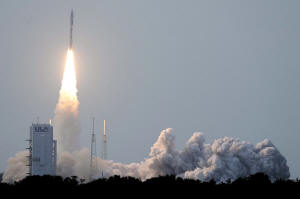|
The
United Launch Alliance's Atlas V rocket carried up 27 of
Amazon's Project Kuiper satellites, named after the frigid
fringes of our solar system beyond Neptune. Once released in
orbit, the satellites will eventually reach an altitude of
nearly 400 miles (630 kilometers).
Two test satellites were launched in 2023, also by an Atlas V.
Project officials said major upgrades were made to the newest
version. The latest satellites also are coated with a mirror
film designed to scatter reflected sunlight in an attempt to
accommodate astronomers.
Stargazers oppose the fast-growing constellations of
low-orbiting satellites, arguing they spoil observations. Others
fear more satellite collisions.
Founded by Jeff Bezos, who now runs his own rocket company, Blue
Origin, Amazon aims to put more than 3,200 of these satellites
into orbit to provide fast, affordable broadband service around
the globe.
Elon Musk's SpaceX already has launched more than 8,000
Starlinks since 2019. The company marked its 250th Starlink
launch Sunday night. More than 7,000 Starlinks are still in
orbit some 300-plus miles (550 kilometers) above Earth.
The European-based OneWeb satellite constellation numbers in the
hundreds in an even higher orbit.
Amazon already has purchased dozens of rocket launches from
United Launch Alliance and Blue Origin for Project Kuiper, as
well as others.
“There are some things you can only learn in flight" despite
extensive testing on the ground, said Rajeev Badyal, the
project's vice president.
“No matter how the mission unfolds, this is just the start of
our journey," he said in a statement ahead of the evening
liftoff.
The first liftoff attempt earlier this month was nixed by bad
weather. It took until now to secure another spot in the launch
lineup at Cape Canaveral Space Force Station.
All contents © copyright 2025 Associated Press. All rights reserved

|
|




